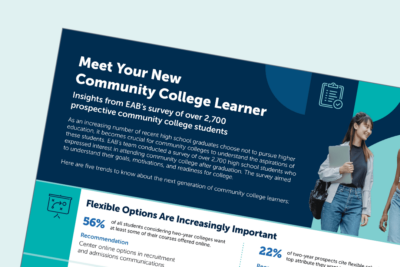Every Interaction Counts: Strengthening Community College Recruitment Communications Amid the Great Opt-Out
Currently in the United States, 8.3 million young adults are not enrolled in higher education, and college-going rates are continuing to decline. As community colleges attempt to grow enrollment, closing the gap on these “nonconsumers” is more important than ever. Many community colleges have made contact with hundreds if not thousands of these prospective students who never enrolled, representing key missed opportunities to boost enrollment.
This white paper shares strategies for better capturing prospective students, developing a communications strategy, and removing their barriers to enrollment. Download the full white paper or read the major takeaways below.
Understanding the great opt-out
While the mass exodus of recent high school graduates might feel new, nonconsumption rates among young people have been rising for the past decade, despite extensive attempts to recruit students. Your college has probably invested in dual enrollment programs, marketing campaigns, and maybe even more recruiters. Despite this, even as high school graduation rates have climbed by 7.2% since 2010, college-going rates, which include community colleges, have declined by 5.6%.
Notably, 61% of nonconsumers who had never attended college applied in the last year, and recent high school graduates are actually applying to more schools than in the past, meaning millions of people are at least curious about what postsecondary education could offer them.
And, while some of these nonconsumers might be hard “no’s” for future enrollment, at least 38% plan to enroll in the future, and 32% are open to considering enrollment. Tapping into this interest and creating continuous enrollment momentum via focusing more intensely on prospective students will be critical for community colleges in gaining ground with younger students.
Sharpen your nonconsumer strategy
Locate and capture your nonconsumers
Prospective students can enter an institution through many different channels that are often disconnected from each other, acting as “side doors” into the college instead of a “front door.” These prospective students may interact with colleges in multiple ways, such as through inquiry forms, community events, or high school visits.
Consolidating your leads into a centralized repository that tracks the origin of the lead, characteristics of the prospective student, and the ability to track their progress toward enrollment increases the likelihood of the student enrolling. Benefits of a centralized approach to lead management that leverages technology include the capacity to:
Respond to students more quickly by adding them to strategic communications campaigns
Capture trends in specific populations of students
Standardize the responses to common questions so students aren’t given the “runaround”
Determine the influence of campus events and recruitment initiatives
Connect multiple student touchpoints to see a student’s journey from interest to application and enrollment
Connect both inbound and outbound initiatives in one place to increase efficiency
Reduce the time spent on manually managing prospective student lists
Create distribution lists, groups, or tags that allow you to communicate easily with specific populations
Centralize your approach toward nonconsumers
Leverage tech to scale communications
While some institutions might question the value of investing in email communication plans, a nearly 10% uptick in Gen Z student engagement with email is supported by EAB marketing data showing that these sources remain vital and effective communication channels, counter to pronouncements about “the death of email.”
One insight gained from EAB’s secret shopper research is that many students who inquire and apply to community colleges never receive a response, receive one too late, or are sent information that isn’t applicable to them. This is in part due to manual, ad hoc processes that are not nimble enough to provide rapid communications, as well as shrinking enrollment teams.
Improved strategy: Deploy communications plans with technology
Building a standardized communications plan, including email templates, text templates, and outreach cadences, helps ensure continuity in your message. This library of templates reduces the time spent creating ad hoc responses to common questions, and leveraging technology allows students to be funneled into multistep campaigns that can help answer questions at scale.
Collect key information from students at the first point of contact, and use that information to leverage custom communications. This will increase the probability of student engagement and reduce stress on teams by getting students to the correct path on the first try.
Using tech-based assistance can allow you to route prospective students to tailored communications that speak to their personal needs, and can help you understand more about who is in your interest pool.
Finally, building a communications calendar and establishing prebuilt outreach cadences can help colleges get ahead of student communications rather than playing catch-up from day to day. Building multistep cadences, especially ones that respond to common questions, can save your team time.
Better communicate with students
Streamline enrollment processes
Many colleges rely on student self-guidance to propel themselves through the enrollment process. For example, your college may direct students to your website for program information or email enrollment checklists, or have a chatbot that helps with basic questions.
However, while Gen Z, which represents the nonconsumer market, likes self-guidance tools and options, they need to be scaled to respond to high student volume and accommodate a diverse student body. Some community colleges may struggle to keep their self-guidance resources up to date and to manage the influx of questions that come from students who are trying to self-guide but cannot find what they need.
Build a strong foundation of support for prospective students
Track your impact
Community colleges may have difficulty understanding which of their prospective students aren’t moving forward and why. Additionally, institutions may not understand which of their recruitment and outreach strategies are most effective.
Deciding which data points to prioritize as measures of your success can be a large task. Leveraging data analytics and visualization tools can help with building your data strategy, making data actionable, and sharing insights with the larger college.
Measure your effectiveness download the full white paper

More Resources

College Search Trends Across Space and Time: 2025 Edition

58 student survey questions for community colleges
